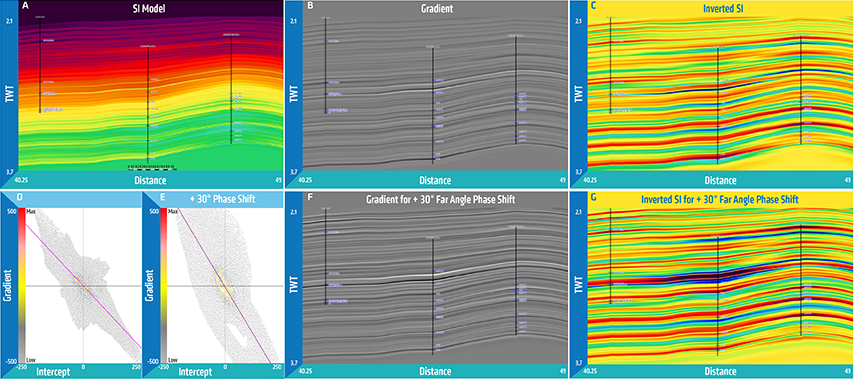Marine ‘broadband’ signal processing flows typically incorporate a combination of free-surface deghosting, spectral shaping, and attenuation compensation. Overall, there are many opportunities to corrupt the phase content in an angle-dependent and frequency-dependent manner during any signal processing flow, and such risks may increase during aggressive ‘broadband’ flows.
This October First Break article outlines a synthetic modeling study that was conducted to quantify and understand how angle-dependent time shifts, angle-dependent frequency variations, or frequency-dependent phase errors can impact the recovery of elastic impedance attributes using pre-stack simultaneous seismic inversion. All modeling and inversion was 2D in nature, included no noise considerations, and assumed the velocity model was perfectly understood.
Several North Sea wells were used to build realistic 2D earth models and a broadband wavelet was extracted from real dual-sensor broadband data and convolved with the earth models to produce near, mid and far angle stacks.
The simple synthetic data analyses presented in the paper highlight some pitfalls when attempting to QC seismic data being used for pre-stack inversion. For example, the detection of angle-dependent low frequency amplitude variations may be difficult as they are not apparent on either frequency spectra or cross-plots of Intercept and Gradient data. Angle-dependent time shifts or high frequency variations tend to have similar expressions upon inversion results. The most serious problems arise due to angle-dependent low frequency phase errors: significant errors in the estimated Shear Impedance and Vp/Vs ratio cannot be mitigated by trim statics or offset-dependent spectral corrections (ODSC) application, and the estimated Gradient error may also be moderately large. Angle-dependent variations in low frequency content (with no phase or time shift errors) can also create significant errors in the estimated Shear Impedance and Vp/Vs ratio, and may not be detectable on Intercept-Gradient cross-plots before or after ODSC application.
Overall, these results reinforce motivations to pursue broadband pre-stack processing solutions (free-surface deghosting, spectral shaping, and attenuation compensation) that are as deterministic and predictable as possible, and less likely to introduce statistical variability in angle-dependent and/or frequency-dependent phase shifts that are clearly easy to overlook even on noise-free data such as the synthetics considered here.

(A) Reference synthetic earth model (color = Shear Impedance: SI); (B) Gradient from synthetic stacks; (C) Inversion of Shear Impedance using synthetic stacks; (D,E) Intercept-Gradient cross-plots before and after +30° phase rotation of all far angle stack frequencies; (F) Gradient from synthetic stacks after +30° phase rotation of all far angle stack frequencies; (G) Inversion of Shear Impedance using synthetic stacks after +30° phase rotation of all far angle stack frequencies.
Contact a PGS expert
If you have questions related to our business please send us an email.